
Leominster is a city in Worcester County, Massachusetts, United States. It is the second-largest city in Worcester County, with a population of 43,222 at the 2023 census. Leominster is located north of Worcester and northwest of Boston. Both Route 2 and Route 12 pass through Leominster. Interstate 190, Route 13, and Route 117 all have starting/ending points in Leominster. Leominster is bounded by Fitchburg and Lunenburg to the north, Lancaster to the east, Sterling and Princeton to the south, and Westminster to the west.
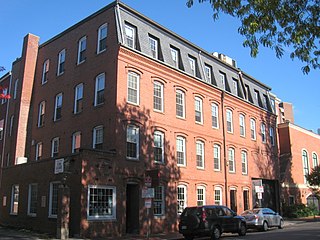
The Reversible Collar Company Building is a historic factory building at 25–27 Mt. Auburn & 10–14 Arrow Streets in Cambridge, Massachusetts. The building has a complex construction history, consisting of several buildings constructed separately between 1862 and 1907, and gradually combined into a single structure. The oldest portions were built by Allen and Farnham, a printing business. The property was sold to the Reversible Collar Company in 1867, which expanded the facility. The company at first manufactured paper shirt collars, but later also produced paper and paper-fabric combinations for use in products like wall charts and maps. The buildings on the site were sold to the Boston Bookbinding Company in 1897. In the late-1960s the building was converted to office and commercial space.

The Wachusett Shirt Company is an historic industrial complex at 97-106 Water Street in Leominster, Massachusetts, United States. The five-building complex was developed between 1887 and 1910, and was home to one of the city's leading employers until the 1930s. Most of the complex converted into a residential complex known as Riverway Apartments in 1981. It was listed on the National Register of Historic Places in 1982.
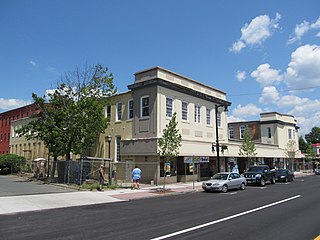
The United States Whip Company Complex or "United States Line Company Complex" is a historic factory located in Westfield, Massachusetts. It was owned and operated by one of the whip-making businesses that led Westfield to become widely known as "Whip City". United States Whip, created in 1892 by the consolidation of several local manufacturers, was the world's largest manufacturer of whips. The factory complex was listed individually on the National Register of Historic Places in 1983, and as part of an expanded Westfield Center Historic District in 2013.

The Whitney & Company building is a historic industrial facility in Leominster, Massachusetts. The utilitarian brick four-story building was built in 1893, and extended in 1923. It was built by Fred Abbot Whitney and Walther F. Whitney, whose business was the manufacture of boxes, notably paper boxes and satin-lined boxes, used for shipping other products to customers. The site was listed on the National Register of Historic Places in 1989. It has since been converted into residences called the Watermill Apartments.

St. Mary's Roman Catholic Church Complex is a historic multi-building church complex at 133 School Street in Waltham, Massachusetts. Established as a parish in 1835, it is the city's oldest Roman Catholic establishment. Its 1858 Romanesque Revival church and 1872 Second Empire rectory are particularly fine architectural examples of their styles. The complex was listed on the National Register of Historic Places in 1989.

The Smith Carriage Company District encompasses three buildings on Park Street, Springfield, Massachusetts, between Main and Willow Streets. The buildings, located at 12, 14–38, and 11–31 Park Street, are noted for their historic association with the locally important Smith Carriage Company, a major manufacturer of carriages in the 19th century. The district was added to the National Register of Historic Places in 1983.

The Arlington Mills Historic District encompasses a major 19th century textile manufacturing complex in Lawrence and Methuen, Massachusetts. Developed between 1865 and 1925, it was one of the state's largest textile operations at its height. At the time of its listing on the National Register of Historic Places in 1985, the mill complex was owned by Malden Mills.
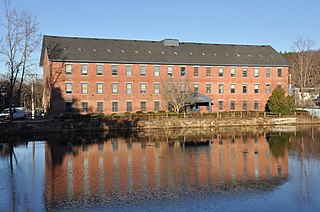
The Ballardvale District in Andover, Massachusetts, encompasses the historic mill village of Ballardvale in the northwestern part of the town. It is centered on the crossing the Shawsheen River by Andover Street, and includes buildings on High Street, Center Street, and other adjacent roads on both sides of the river. The district was listed on the National Register of Historic Places in 1982.
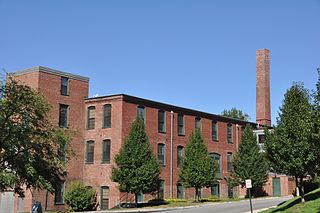
The Walker Body Company Factory is a historic factory complex on Oak Street at River Court in Amesbury, Massachusetts. It has been converted to residential use.

The Southbridge-Sargent Manufacturing District encompasses a collection of three 19th-century factory buildings near a historically important railroad junction in southern Worcester, Massachusetts. They were built near the intersection of Sargent and Gold Streets, just south of Southbridge Street. The location is close to a junction of three major railroads: the Boston and Albany, the Norwich and Worcester, and the New York, New Haven, and Hartford. The area was once a major industrial part of the city, but has lost many of its historic factory buildings in the 20th century.

The Ashworth and Jones Factory is a historic building at 1511 Main Street in Worcester, Massachusetts. It is one of the architecturally finest mid 19th century factory buildings in the city. Built in 1870 and repeatedly enlarged, most of its sections retain high quality brickwork and mid-19th century Victorian styling. The factory was listed on the National Register of Historic Places in 1980. The complex has been converted into condominium residences known as Kettle Brook Lofts.

The Junction Shop and Hermon Street District is a historic district comprising 28 industrial properties on Jackson, Hermon, and Beacon Streets on the south side of Worcester, Massachusetts. It is a remnant of a once larger 19th and early 20th century manufacturing district just west of the railway junction between the Boston and Maine Railroad and the New York, New Haven and Hartford Railroad. It was listed on the National Register of Historic Places in 1980.

The Central Mills Historic District encompasses a historic mill complex on the Quinebaug River in central Southbridge, Massachusetts. Located at the corner of Foster and North Streets, the site consists of three brick buildings, the oldest of which has portions dating to 1837. Despite being extensively rebuilt in the early 20th century, the complex has an appearance that is more typical of 19th century mills.

The Saco–Pettee Machine Shops is a historic factory complex at 156 Oak Street in the Newton Upper Falls area of Newton, Massachusetts. Although the area has an industrial history dating to the early 19th century, the oldest buildings in this complex, consisting of about thirteen brick buildings, were built in 1892. The property, a major economic force in the development of Newton Upper Falls, was listed on the National Register of Historic Places in 1986. It was home to Clark's N.A., the North American home base to Clark's Shoes, makers of fine footwear, until they relocated to Waltham Ma. in October 2016.

The Nashua Manufacturing Company Historic District in Nashua, New Hampshire, is a historic district that was listed on the National Register of Historic Places (NRHP) in 1987. It encompasses an area just west of downtown Nashua, roughly located along the southern bank of the Nashua River, bordered on the west side by Mine Falls Park, on the south side by the Nashua River canal, up to Ledge Street, and from the east side by Factory, Pine and Water streets, up to the Main Street bridge.
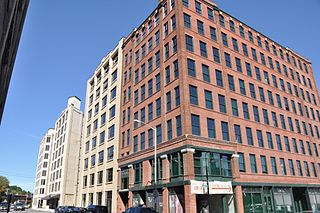
The L.H. Hamel Leather Company Historic District encompasses the largest tract of intact historical industrial buildings in downtown Haverhill, Massachusetts. The monumental factory complex of the L.H. Hamel Leather Company is located just west of Haverhill's central business district, and is roughly bordered on the west by the right-of-way for the former Boston & Maine Railroad, Essex Street on the south, Locke Street and Duncan Street on the east, and Winter Street on the north. The complex, which was built up between 1886 and 1929, was listed on the National Register of Historic Places in 2009.

The Jaffrey Mills is a historic mill complex at 41 Main Street, in the central business district of Jaffrey, New Hampshire. It consists of a connected series of primarily brick buildings flanking the Contoocook River just north of Main Street. Its oldest buildings, the original mill and office building, are on the west side of the river. They were built in 1868, and feature mansard roofs and banded dentil brick cornices. The mill building has a tower that originally sported a cupola, but this was removed early in the 20th century. In 1872 the building on the east side was built, and the two sides joined by timber-frame bridges were added in 1897, at the same time the east building was extended northward. Later additions to the north of the east building include a storage area and a loading dock. The mill complex, the only 19th-century industrial complex of its type to be built in Jaffrey, was listed on the National Register of Historic Places in 1982. It has been converted into residences.
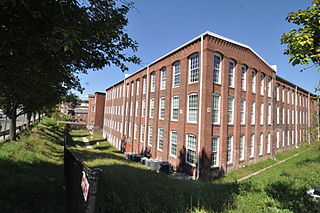
The Nashawannuck Mills Historic District of Easthampton, Massachusetts encompasses a 19th-century industrial complex on Cottage Street in the heart of the town. Most of the connected series of brick buildings were built between about 1848 and 1870, although the facilities were used for industrial purposes until 1970. The oldest building erected was by Samuel Williston for a button factory. Powered by a dam that impounded Bound Brook, the facility expanded in both size and function, eventually becoming a major producer of elastic fabrics for goods such as suspenders and webbing. The industrial works were the major economic engine in Easthampton into the 20th century. The district was listed on the National Register of Historic Places in 2015.
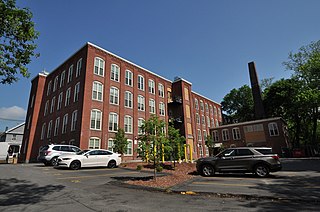
The W. S. Reed Toy Company-Wachusett Shirt Company Historic District encompasses two adjacent properties at 41 and 45 Summer Street in Leominster, Massachusetts. The two properties were historically associated with the business operations of William S. Reed, a businessman who operated a toy manufacturing company among other concerns. The properties were listed as a historic district on the National Register of Historic Places in 2021.























